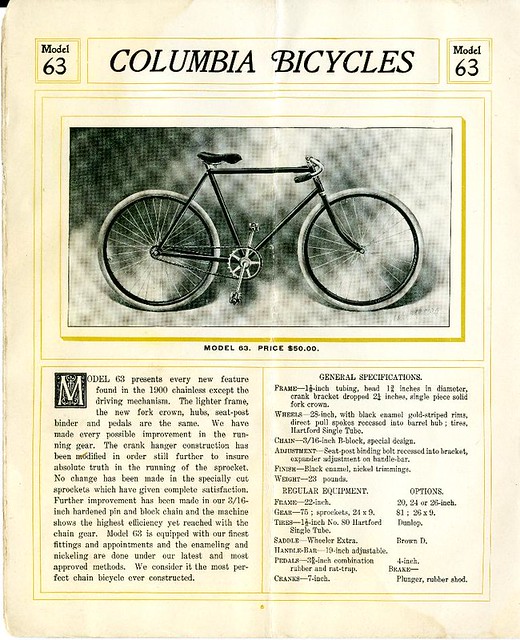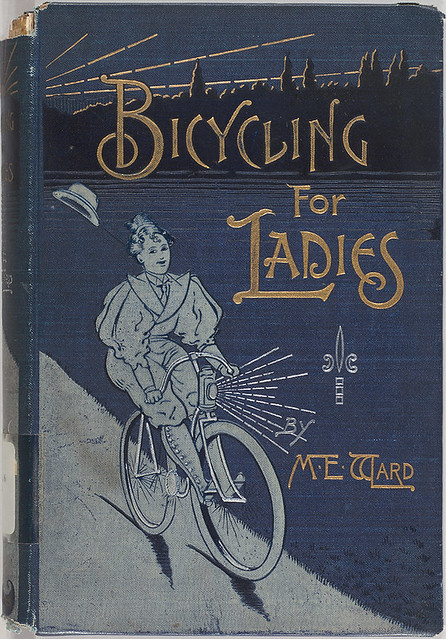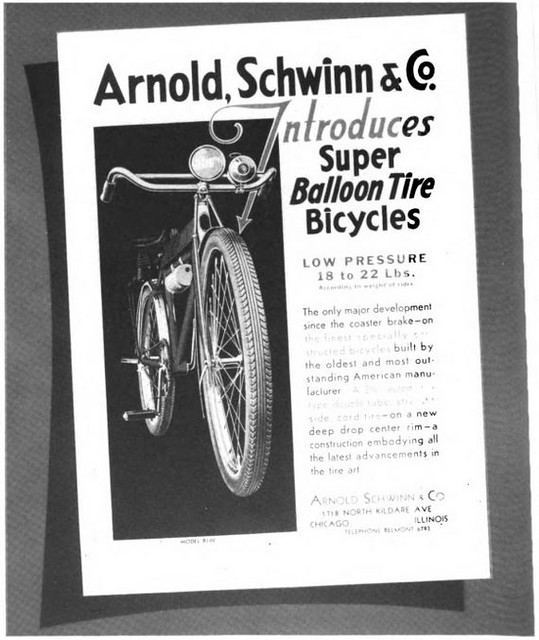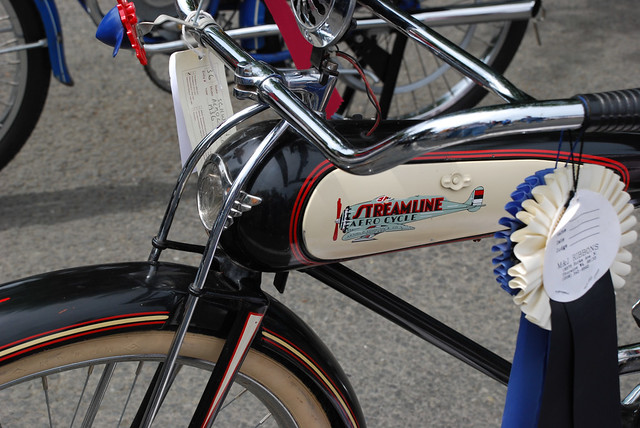I have three bikes that I ride, but my approach is far more . . . . . well, I'm cheap, for one thing. And since I commute in all kinds of weather, I take the approach of having three different bikes that are suitable for different conditions. (I am not a one-type-bike-fits-all-situations person.) I don't concern myself with the historical accuracy (period correctness) of the components on my 1982 Bridgestone, for example, which has brand new wheels (that aren't the right size, in fact) and only use period components where more or less required (and cheap! did I mention cheap?), like the handlebar stem.
Still, I was thinking about what three bikes I consider most significant even if I wouldn't want to own ridable (or just viewable) examples of them. I guess I would choose an 1890s Columbia, a 1930s Schwinn with balloon tires, and a 1980s Specialized mountain bike. I regard all these bikes has having significance both good and bad, which I'll try to explain. (Keep in my these are just my ruminations, I am not a bicycle historian of some sort.

Columbia single speed bicycle in 1900, with a brake only as an option
The catalog page above is for a somewhat later version of the bike I have in mind from Columbia, but in 1900 it is mostly the same. This was the kind of bicycle that was common during the "bicycle craze" of the mid-to-date 1890s in the U.S. - a fairly utilitarian and simple bicycle, with fixed gearing - you could only coast by putting your feet on small posts on the side of the front fork - and a true brake as we understand them today was optional equipment. The combination of fixed gear and lack of a brake made such bikes more difficult and perhaps thrilling to ride than a typical modern bike even though visually they look much the same.

Bicycling for ladies : with hints as to the art of wheeling, advice to beginners, dress, care of the bicycle, mechanics, training, exercise, etc., etc. / by Maria E. Ward. Published 1896.
Such bicycles were significant in providing opportunities for American women to develop greater independence. The above image is from the cover of a book at the time to provide women guidance on riding bicycles - the rider has her feet up on the fork, coasting dramatically at high speed. These bikes were what made this all possible.
At the same time, there was a serious drawback, which was that these bicycles were marketed with single-tube tires and rims intended for single-tube tires that were tedious to repair when flat. It quickly became clear that there were better approaches for consumers but manufacturers were more interested in keeping their coasts low. It does not seem likely that the difficult-to-fix tires did anything other than work against the interests of consumers to buy bicycles, and then of course there was the introduction of the automobile . . . . .

1933 ad for Schwinn's new balloon tires (bike included)
This business with tires is why I would suggest this somewhat odd Schwinn from the 1930s was the next significant bike I would choose - it has balloon tires with inner tubes that were far easier to maintain. It took an absurdly long time, but a bicycle manufacturer finally broke the pattern of offering consumers mostly bicycles that had a serious built-it problem in terms of tire repair. And in fact the balloon tires meant a bicycle owner could have a more casual attitude towards maintaining tire pressure altogether.

Early Schwinn Aerocycle from Natalie Wilkie
The drawback of this bike, however, was that it was a diversion of the bicycle manufacturers into a focus on bicycle as toy, or anyway, of bicycles as something to market to people who couldn't yet drive (and their parents) in ways that were not, unlike the balloon tires, particularly utilitarian but rather about marketing. In a way, this was running up the white flag to the auto industry.

Early Specialized Stumpjumbers from Hugo Cardoso
My third choice of a Specialized Stumpjumper is not based on any particular fondness for or interest in Specialized or that bike, but according to a Wikipedia article this was the first mountain bike, so we'll take that as sufficiently authoritative. For me personally, the appearance and my eventual recognition of the existence of mountain bikes was not on that they were mountain bikes but rather that there was this alternative to road bikes, which eventually got me back to riding a bicycle as an adult. Road bikes (this is amusing for me now) held no attraction, largely because I seemed to have thought they could or should only be ridden on roads which I didn't want to do. A fellow where I worked who lived nearby rode back and forth most days on a nice mountain bike (mostly on paved trails) and I was inspired by his example to do so also. I'm still not sure what would have happened if he had been doing this on a road bike.

My 1995 Trek Singletrack - a mountain bike, sort of, that that I recently acquired (but don't ride on mountains, or even gravel)
So I think that the mountain bike, and the many variants that have appeared since, have helped to get more people riding. This is mostly good. I kind of feel however that there is a downside in that the bicycle manufacturers now seem to see the creation of new bicycle "types" as their salvation for sales. For example, so-called "gravel bikes." I mean, I know there really are "gravel cyclists" but uhm not so many to support all the gravel bikes being produced, I suspect. Or say fat bikes - I recently went to buy something at a nearby REI and the fat bike near the entrance, front-and-center, struck me mostly as a tedious example of marketing wishful thinking and certainly not as an attractive bicycle - here "attractive" meaning "I'm gonna buy one."
And here we circle back to the 1890s, because in fact already at the height of the bicycle craze, the problem the manufacturers were facing was how to come up with new designs - a Columbia bicycle model of 1898 that was significantly different from the Columbia model for 1897 that would generate ever more sales of new bicycles. (I am not much of a friend of the bicycle manufacturers these days since I only seem attracted to used old bikes.) In fact, in 1900, the bicycle shown at the beginning of this blog post was offered as the inferior option when compared to the shaft-drive bike that was new(er) technology that they were insisting was better. (It wasn't better. Do you see anyone riding a shaft-drive bicycle? No, practically never.)
No comments:
Post a Comment